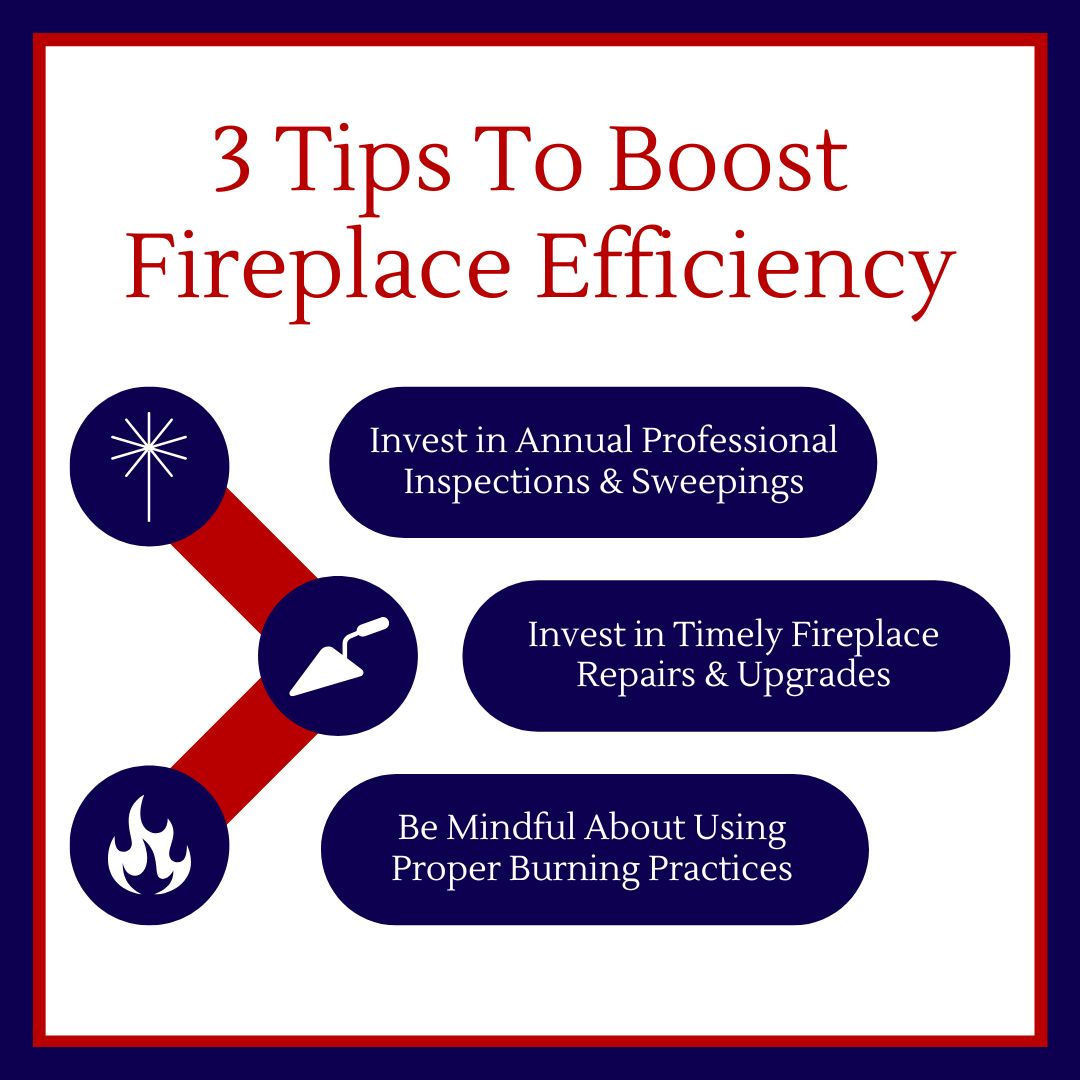As Texans know, enjoying mild winters doesn’t mean there’s never a chill in the air. And when colder temperatures set in, homeowners here can enjoy the warmth and ambiance a fireplace provides. The attractiveness of a fireplace as a heat source, however, can be undercut by inefficiency.
That’s why it’s wise to think about ways to maximize the quality and efficiency of your fireplace and chimney performance – not only for potential savings on utility costs, but for the long term enjoyment of all this desirable home system has to offer. Need professional advice or service? We’re here to help – call or book online now.

Fireplace Efficiency Tip 1: Invest in Annual Professional Maintenance
Experts agree that the best thing you can do for your fireplace all-around is keep it well maintained. This entails annual inspections, sweepings, and smart updates and fixes.
Annual inspections by a CSIA-certified professional help ensure things are operating as they should. An inspector will check for cracks, blockages, deterioration, or structural issues. These issues, if present, can lead to heat loss, ventilation issues, and premature system breakdown. Having them identified early on can lead to swift remediation and a well-running system.
Having your chimney professionally swept is also essential to ensure it’s free from buildup that can block airflow and cause inefficiency (and present potential fire hazards). A clear chimney allows smoke to exit your living space as it should, and it promotes clean, efficient blazes.
Fireplace Efficiency Tip 2: Invest in Repairs & Upgrades
If an inspection reveals components that are damaged or worn, replacing them promptly is a good move. A damaged chimney cap, for instance, is a weak link that can allow debris into your system and cause blockages. Or a damper that no longer seals well won’t do as much to guard against inefficient air movement. Basically, you need each part of your chimney system to do its job well to maximize efficiency.
If your fireplace doesn’t have fireplace doors, installing them may be another smart system move. Glass doors designed for fireplaces are a fairly easy improvement, and they can significantly improve temperature regulation by creating a barrier to keep warmed or cooled air in your home – right where you want it.
Sometimes, an entire fireplace upgrade will be beneficial, even if all parts of your chimney system are intact. That’s because the chimney industry, like others, benefits from advances in engineering and technology. Consider adding a fireplace insert to your open fireplace, for instance, for more warmth in your living space. Inserts are designed to fit into existing, open fireplaces, and boast a range of benefits:
- Typically, they come with blowers to help circulate air throughout the room.
- They promote an efficient burn.
- They don’t allow as much heat loss as a traditional fireplace, reducing the amount of energy needed overall.
- They also reduce drafts.
- They provide a chance to introduce system changes or new features, like a change in fuel type.
- They tend to be much more eco-friendly than older systems.
Fireplace Energy Efficiency Tip 3: Be Mindful of Burning Practices
How can you, the homeowner, ensure efficiency when using your fireplace?
Always open your damper when your fireplace is in use, and always close it when it isn’t. This will allow your fireplace to do its job, guiding smoke and combustion gases safely outside of your home, and help reduce energy loss when you aren’t using your system. If you struggle to remember this step, consider having an automatic damper installed.
Another important tip for wood-burning fireplaces is to use only well-seasoned firewood as fuel. Burning non-wood items (such as packaging, plastics, cardboard, or magazines) or treated wood can release toxins into the air in your home and increase the risk of an uncontained fire. And burning wet or green (freshly cut) wood is inefficient – your fire will spend its energy trying to zap the excessive moisture content rather than giving you a nice, cheery blaze. This means a weaker, smokier fire that is more likely to cause tarry creosote deposits inside your chimney.
Another efficiency consideration is air leaks at the edges of your fireplace. Over time, the seal around your fireplace might degrade, which can cause undesirable air exchange through the leaks. Seal these gaps with a suitable, high-temperature sealant to minimize or eliminate this issue.
Partner with Lord’s Chimney to Keep Your Fireplace Running Efficiently
Fireplaces add beauty and warmth to a home that goes beyond temperature regulation, but that’s no reason not to get the most warmth and energy-saving benefit that you can. A chimney system is surprisingly complex, and its role in keeping your home safer while you enjoy your fireplace is vital. That’s why we’ve invested over a decade in learning the industry inside-out.
If you have questions about system efficiency, require a chimney cleaning or inspection, or are looking for an installation or upgrade, we’re the team to call on. Expert, local, customer-oriented service with your safety and needs in mind – that’s what you can expect from Lord’s Chimney. Reach out now.

